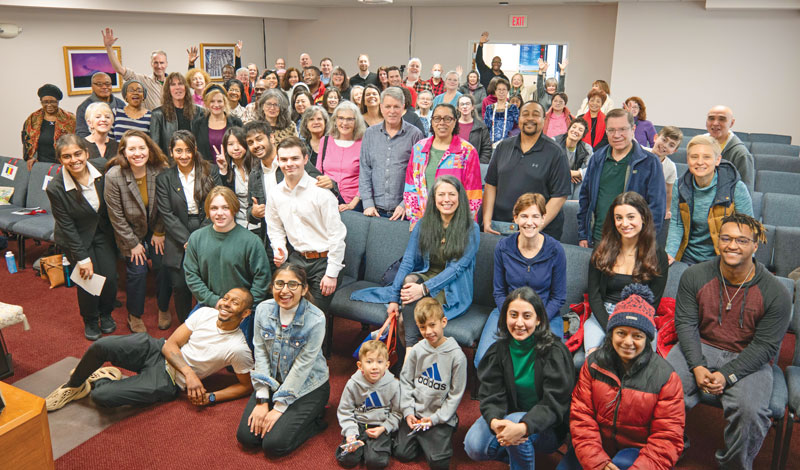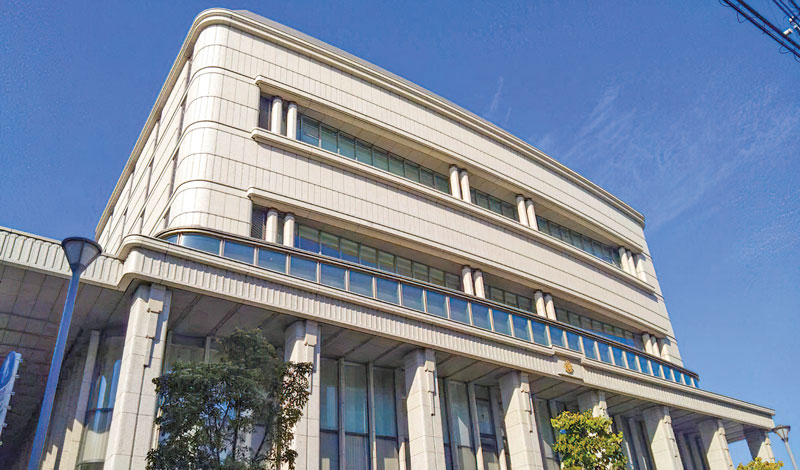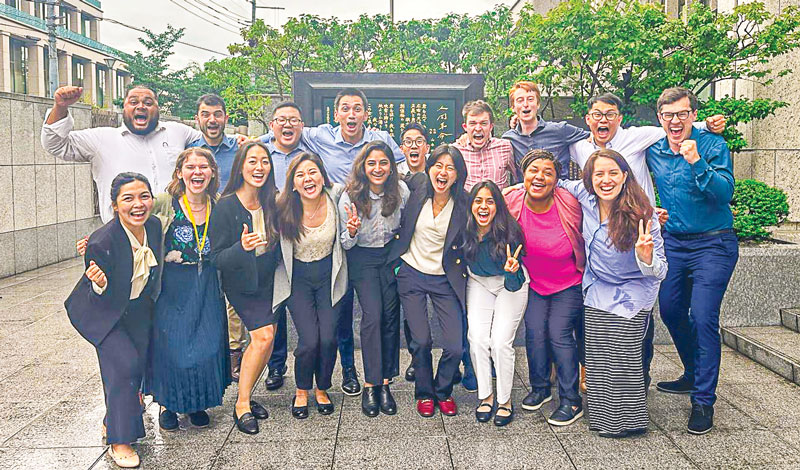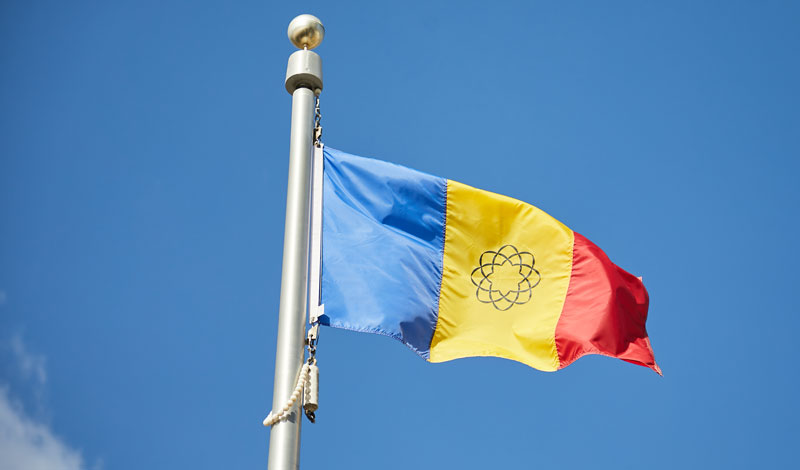The following is an essay from the “Our Brilliant Path to Victory” series, published in the November 21, 2010, issue of the Seikyo Shimbun, the Soka Gakkai’s daily newspaper. In this essay, Ikeda Sensei reviews by decade the 80-year history of the Soka Gakkai under the leadership of the three founding presidents and looks ahead toward the Soka Gakkai’s centennial on November 18, 2030.
With cheers echoing,
we celebrate
the day of founding,
walking the path to happiness
throughout the three existences.
Ah, November 18! The brilliant and immortal anniversary of our founding! This year [2010], it marks the Soka Gakkai’s 80th birthday.
In the predawn hours of this auspicious day, some of our members observed shooting stars from the Leonid meteor shower, saying that it felt like a cosmic celebration of our anniversary. This would have been about the same time as our noble Seikyo newspaper deliverers were setting out into the cold to make their morning rounds.
The universe, vast and timeless, is filled with infinite stars. The twinkling light of the stars in the night sky gives hope and courage to people in every region and country.
To turn back the darkness of the times, an inspiring multitude of capable people—burning with an indelible commitment—is now emerging from the great galaxy of value creation that is the Soka Gakkai, like the myriad stars in the heavens that shine brightly through the blackness of space.
In “The Opening of the Eyes,” Nichiren Daishonin writes, “This is my vow, and I will never forsake it!” (The Writings of Nichiren Daishonin, vol. 1, p. 281). A life dedicated to fulfilling a vow or commitment is the happiest life there is. Those who sincerely continue their efforts to actualize their commitment, undefeated by the harshest storms of adversity, are true champions, true victors.
We, the members of the Soka Gakkai, walking the path of mentor and disciple, are striving to fulfill a great and noble vow—a great commitment that we never lose sight of, whether waking or sleeping. This is the vow to work for kosen-rufu, the mission entrusted to us by Nichiren Daishonin. Pledging to propagate the Mystic Law in the evil age of the Latter Day, we have voluntarily chosen to be born as Bodhisattvas of the Earth.
My mentor, second Soka Gakkai President Josei Toda, articulated that vow as “eradicating misery from the face of the earth.” As long as misery exists on this planet, the struggle of the Soka Gakkai continues.
How earnestly our members have chanted, taken action and challenged themselves! How tirelessly they have spoken out, championed the truth and advanced our movement for kosen-rufu! In complete accord with the predictions of persecution that are made in the Lotus Sutra and the Daishonin’s writings, we of the Soka Gakkai have been subjected to slander and abuse, defamatory attacks motivated by hatred and jealousy, and harsh oppression by the authorities, whose actions embodied the workings of devilish functions. But we have triumphed over all. While struggling with our own personal karma, we have supported and encouraged countless others, assuring them that they could definitely become happy. Wishing for the happiness of ourselves and others, we have chanted for world peace and raised high the banner of the victory of the people.
The resonant sound of our chanting Nam-myoho-renge-kyo envelops the planet and surely reverberates into the farthest reaches of the universe. Nichiren Daishonin and his successor, Nikko Shonin, are surely bearing witness to this solemn truth.
As we celebrate this milestone 80th anniversary, I declare that we have won! The mentors and disciples of Soka have won! Each one of you has won! All of us in our own unique way have triumphantly celebrated the 80th anniversary—the birthday of the Soka Gakkai, an event that shines with the victory and glory of the people.
One Lion Standing Alone
The anniversary of our founding
is also the day of the martyrdom
of our first president,
a mystic destiny decreed
by Buddha wisdom.
On November 18, 1930, founding Soka Gakkai President Tsunesaburo Makiguchi and his disciple, Josei Toda, published the first volume of The System of Value-Creating Education (Soka kyoikugaku taikei), a groundbreaking work calling for an educational revolution. The name Soka Kyoiku Gakkai (literally Value-Creating Education Society, the forerunner of the Soka Gakkai) appeared in print for the first time in the publisher’s information at the end of the book.
Born in a troubled age, the Soka movement thus began from the publication of this volume, which was realized through the united purpose of mentor and disciple. Mr. Makiguchi died in prison for his beliefs on the same date—early on the autumn morning of November 18, 1944. When Mr. Toda, who had been imprisoned along with him, learned of this news [two months later in January 1945], his heart was filled with bitter grief and anger—feelings that galvanized in him a powerful resolve to vindicate his mentor. Around the same time that Mr. Makiguchi passed away, Mr. Toda experienced a profound realization in his prison cell that he was a Bodhisattva of the Earth; he had awakened to the ultimate essence of the Lotus Sutra and made a vow to carry out kosen-rufu.
Buddhism teaches the oneness of life and death. In that sense, I feel certain that Mr. Makiguchi was with Mr. Toda as he experienced his great awakening in prison, and that, entrusting the mission for kosen-rufu from time without beginning to his disciple, he then departed for the pure land of Eagle Peak.
Mr. Toda said, “I was born to be at Mr. Makiguchi’s side, like a shadow clinging to its form, throughout life and death.” Mr. Toda had decided to shoulder all the hard work and responsibility himself and to dedicate his victories to his mentor, Mr. Makiguchi. In my youth, I also dedicated myself completely to my mentor, Mr. Toda. I fought with lionhearted resolve to realize my mentor’s vision. I felt that even if I should die in that cause, I would have not the slightest regret.
The presence of disciples determined to realize the mentor’s vision is crucial to the Soka Gakkai’s eternal victory. Every age needs genuine disciples who will stand up and demonstrate proof of our movement’s ongoing success. Even one person is enough.
The well-known American Buddhist journalist Clark Strand writes that the profound gratitude one feels for one’s mentor becomes, in turn, one’s strong motivation for mentoring others, and that this is how the teaching is passed along.[1]
I completely entrust the future to you, my successors. I want you to be victorious for Buddhism, for the Soka Gakkai, for all our beloved members, for your parents and for yourselves.
True victory means to continue winning. Holding high the banner of Nichiren Buddhism, the supreme teaching of value creation and human revolution, let us forever triumph and prosper.

Brim With the Vibrant Life Force of Youth!
Embracing the Mystic Law, which is the source of perennial youth and an eternally vibrant life force, the Soka Gakkai will forever brim with youthful vigor and forge ahead energetically. The vitality of our organization hinges on its youthfulness.
At present in Japan, our Soka youth are making unprecedented efforts to reach out to others in dialogue to share Nichiren’s teachings with them. This includes our young men’s division members, spirited champions of truth; our young women’s division members, who overflow with good fortune and wisdom; and our student division members, who combine courage with intellect.
I served my mentor from the time I was 19 until I was 30. During that decade or so, he taught me the essence of the oneness of mentor and disciple and faith for achieving absolute victory. My mentor had complete confidence in me.
Youth are hope. The Soka Gakkai has triumphed through youth giving full play to their unlimited potential.
Winning in one’s youth serves as an important foundation for enjoying victory throughout one’s life. I hope you’ll make your youth a time when you achieve a record of accomplishment that you can be proud of all your life.
The History of Soka, Decade by Decade
I would like to briefly review the 80-year history of the Soka Gakkai under the leadership of the three founding presidents, decade by decade.
1930–1940
The 1st Decade to the 10th Anniversary
In the interval between the two world wars, at a time when nationalism sowed division around the world and totalitarian rule reduced people to faceless masses, Mr. Makiguchi and Mr. Toda stood up to declare that the happiness of children and the happiness of each individual should be our first priorities. With that goal in mind, they began to propagate the teachings of Nichiren Buddhism and engage in dialogue to establish the correct teaching for the peace of the land.
1940–1950
The 2nd Decade to the 20th Anniversary
As Japan embarked on its disastrous war, Mr. Makiguchi and Mr. Toda courageously resisted the rising tide of militarism spreading throughout the land. Our founding president died in prison defending freedom of religion. Committed to proving the greatness of his mentor whose vision he had inherited, Mr. Toda stood up alone amid the ruins of a defeated Japan and revived the teachings of Nichiren Buddhism in modern times. He launched an unprecedented movement to enlighten and empower people everywhere. I encountered my mentor at 19, and he trained me rigorously.
1950–1960
The 3rd Decade to the 30th Anniversary
Under the leadership of Mr. Toda, who had been inaugurated as second Soka Gakkai president, I spearheaded the efforts of the youth, which brought about significant breakthroughs for our movement as we achieved our goal of 750,000 households. Though the public derided us as a “gathering of the poor and sick,” and the authorities harassed and persecuted us out of their general contempt for ordinary people, we built the foundation for an invincible bastion of Soka, befitting its position as “the king of the religious world,” which Mr. Toda had proudly proclaimed it to be. The united efforts of mentor and disciple are the very essence of “faith for absolute victory” in the Soka Gakkai. Mr. Toda also asserted the importance of global citizenship and issued his declaration for the abolition of nuclear weapons, steering the Soka Gakkai toward its wider mission of global peacebuilding.
1960–1970
The 4th Decade to the 40th Anniversary
Having been inaugurated as the third president of the Soka Gakkai at 32, I actualized a number of my mentor’s dreams and plans for the future. In Japan, our membership grew to 7.5 million households. I traveled extensively around the world to achieve the mission of global kosen-rufu and world peace entrusted to me by Mr. Toda, sowing the seeds of the Mystic Law in the lives of countless individuals. I also founded the Tokyo Junior and Senior High Schools, the Min-On Concert Association, the Komei Party [2] (now New Komeito) and other institutions. For the sake of peace and stability in Asia and the world, I called for the normalization of diplomatic relations between Japan and China.
1970–1980
The 5th Decade to the 50th Anniversary
I engaged in numerous dialogues with leading world thinkers, such as the eminent British historian Arnold J. Toynbee[3] (1889–1975). Undeterred by Cold War barriers, I visited China and the Soviet Union and also promoted dialogue among civilizations. I continued to devote my efforts to enhancing and expanding the Soka school system, including founding Soka University in Hachioji, Tokyo. I threw myself wholeheartedly into developing a movement for peace, culture and education based on Buddhism. As part of that effort, I founded the Soka Gakkai International (SGI) and set about extending our grassroots network around the world.
1980–1990
The 6th Decade to the 60th Anniversary
Burning with the mentor-disciple spirit that is the heart of the Soka Gakkai, I began a counteroffensive to ensure that the truth and integrity of our movement would prevail.[4] I foiled the malicious plots designed to undermine our united momentum and strove to impart to our members the fundamental Soka Gakkai spirit of taking personal initiative and warmly encouraging each person. I completed my personal goal of establishing a firm foundation for kosen-rufu in Japan by my 60th birthday.
1990–2000
The 7th Decade to the 70th Anniversary
The Soka Gakkai reaffirmed its unequivocal commitment to the position that religion must exist for the sake of human beings, and not the other way around. Determined to remain an organization always dedicated to people’s happiness, the Soka Gakkai took a great leap forward in making Nichiren Buddhism a truly open and universal religion.[5] I traveled around the globe in the post–Cold War era, holding high the spirit of respect for human dignity and the sanctity of life that is the essence of Nichiren Buddhism. Through engaging in dialogues with international leaders such as Soviet President Mikhail Gorbachev, South African President Nelson Mandela and German President Richard von Weizsäcker, I showed that Buddhist humanism and the philosophies of the world’s leading thinkers are attuned with one another at the deepest levels.
2000–2010
The 8th Decade to the 80th Anniversary
Our movement for peace and humanity became truly global in scale, spreading to 192 countries and territories. The humanism of Nichiren Buddhism was elevated to a universally accessible philosophy, and a steady stream of capable individuals striving for peace and committed to widely spreading the Mystic Law appeared around the globe, one after another, just like the bodhisattvas who emerged from the earth in the Lotus Sutra. The time has come when thinking people everywhere look to our movement with the highest admiration and aspirations. The foundation for worldwide kosen-rufu and a century of genuine humanism have been established.

I can now confidently report to my mentor: “The network of Soka successors has achieved a brilliant victory.” There is no greater happiness for disciples than being able to report their victory to their mentor.
When the Soka Gakkai celebrates its centennial (in 2030), the members of today’s young men’s and young women’s divisions will have grown into not only strong pillars of our organization but also solid pillars of their communities and society, as well as pillars of hope for the world.
A century of peace will be built by champions of dialogue. A century of humanity will come to shine through creative and humanistic individuals. A century of life will be opened by wise people who respect and value life.
My young disciples, with the world as your stage, become leaders of our movement and society! Freely and dynamically exhibit your potential! And work to bring people together, to bring humanity closer together!
The Central Headquarters Is a ‘Fighting Citadel’
On November 18 of this year [2010], the day of our 80th anniversary, the Seikyo Shimbun published a basic description and architectural rendering of the new central Soka Gakkai Headquarters building that is scheduled for construction. Many members have written in to the paper expressing their joy along with fresh determinations in faith.
Such construction projects are all for the sake of our members and the future of kosen-rufu. I want to build solid bases in all areas so that members can practice with pride and a sense of security.
The Soka Gakkai Headquarters is a “fighting citadel” from which we direct our efforts for kosen-rufu, while fending off the three powerful enemies[6] and other negative forces. That’s why Mr. Toda insisted that the headquarters building be functional, sturdy and simple.
Among the reactions to the design, some said it reminded them of the General Headquarters (GHQ) of the Allied Occupation in postwar Japan. This brought back an unforgettable memory of Mr. Toda. About 60 years ago, I was walking with him along the imperial palace moat, where the GHQ building was located, and suddenly it began to rain. We didn’t have umbrellas and had no luck hailing a taxi. This was when Mr. Toda’s businesses were facing their worst crises.
We started walking at a brisker pace, deciding that we had no choice but to get soaked, when Mr. Toda pointed to the headquarters of the Dai-ichi Mutual Life Insurance Company, which housed the GHQ: “That’s where MacArthur[7] is,” he said. At the time, the Soka Gakkai didn’t own any cars, much less large buildings, but I said: “I’m going to work very hard and buy a car that you can be driven around in. I’ll also build magnificent facilities for kosen-rufu. You can count on me.”
New Soka Gakkai centers are rising everywhere around Japan. I know that Mr. Toda must be happy that I’ve kept my promise.
The renowned American architect Frank Lloyd Wright (1867–1959) said, “A great architecture is greatest proof of human greatness.”[8] Soka Gakkai buildings are golden citadels of mentor and disciple, symbols of our unshakable unity.
Fifteen years ago, at the time of the Great Hanshin Earthquake in 1995, our centers in the Kansai area remained steadfast and served as relief centers for people in their communities. I am always deeply grateful to all those involved in the construction of our centers who, taking to heart my concern that safety must be our foremost priority, have built such safe and strong structures.
The American poet Henry Wadsworth Long-fellow (1807–82) wrote, “Build on, and make thy castles high and fair.”[9] My wife and I are praying each day that all of you will build magnificent castles of victory in your families, workplaces, communities and personal lives.

Departure Toward the Centennial
The French author Romain Rolland (1866–1944) writes in the play The Leonids, “Come, let us commence on a grand voyage!”[10]
Our 80th anniversary is not the end. It’s only the starting point for a new journey toward the triumph of the people. My friends, my comrades in the struggle for kosen-rufu: Let’s begin today, continuing on our eternal journey of mentor and disciple, the triumphant and glorious journey of human revolution. Let’s set forward with a renewed commitment to our vow for kosen-rufu, aiming for the shining summit of the centennial of our ever-youthful Soka Gakkai!
Now is the time to stand up,
now is the time to set forth,
and together
resolutely achieve
a life of victory.
From the November 2024 Living Buddhism
References
- Clark Strand, “‘Makiguchi Is Dead!’—The Three Presidents and the Making of the Soka Gakkai International,” www. joseitoda.org/resources/essays/makiguchiisdead (December 3, 2010). ↩︎
- New Komeito: Soka Gakkai in Japan started fielding candidates in local elections in 1955 and in national elections the following year. The motivations for entering the political field were: 1) to protect the constitutional safeguard of freedom of religion and ensure that the state would never again use religion to infringe people’s freedoms or justify war; 2) to represent ordinary men and women in a political system dominated by the interests of either big business or huge labor unions; and 3) to tackle government corruption and bring an ethical perspective into the Japanese political domain. It is the explicit policy of Soka Gakkai International organizations outside Japan that they will not involve themselves in politics. ↩︎
- See Arnold Toynbee and Daisaku Ikeda, Choose Life: A Dialogue (London and New York: I.B. Tauris; reprint edition, 2008). ↩︎
- On April 24, 1979, Daisaku Ikeda stepped down as the third Soka Gakkai president in order to shield the Soka Gakkai members from the machinations of the Nichiren Shoshu priesthood, who colluded with several former Soka Gakkai members to bring about the organization’s downfall. ↩︎
- On November 28, 1991, the Nichiren Shoshu priesthood took a step unprecedented in the history of Buddhism, when they excommunicated 10 million SGI members in an attempt to impose their authority and exert control on the organization. The vast majority of members throughout the world, with deep conviction in a correct understanding of Nichiren Buddhism, chose to practice with the SGI under the leadership of Ikeda Sensei. SGI members around the world now celebrate November 28 as “Spiritual Independence Day.” ↩︎
- Three powerful enemies: Three types of arrogant people who persecute those who propagate the Lotus Sutra in the evil age after Shakyamuni Buddha’s death, described in the concluding verse section of “Encouraging Devotion,” the 13th chapter of the Lotus Sutra. The Great Teacher Miao-lo (711–782) of China summarizes them as arrogant lay people, arrogant priests and arrogant false sages. ↩︎
- General Douglas MacArthur (1880–1964) was the Supreme Commander of the Allied Powers in Japan during the Allied occupation of the country after the end of World War II. ↩︎
- Frank Lloyd Wright, An American Architecture, edited by Edgar Kaufmann (New York: Horizon Press Inc., 1955), p. 44. ↩︎
- Henry Wadsworth Longfellow, “The Castle-Builder,” Poems (Boston: James R. Osgood and Company, 1877), p. 229. ↩︎
- Romain Rolland, Les Léonides (The Leonids) (Paris: Albin Michel, 1928), p. 248. ↩︎
You are reading {{ meterCount }} of {{ meterMax }} free premium articles

